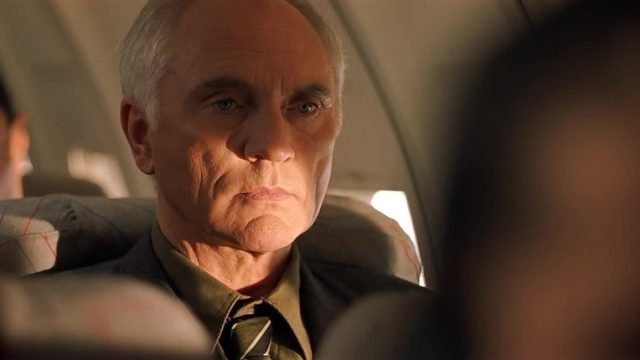The commentary track on Criterion’s edition of The Limey is famous for its sparring match between director Steven Soderbergh and writer Lem Dobbs over Soderbergh’s approach to the script. There’s several squabbles – sometimes bemused, sometimes bitter – that make it worth a listen whatever you think of the final result onscreen (it’s good, though Dobbs’s complaints are fair). There’s also some fleeting compliments, one of them surrounding Soderbergh’s strategy for conveying the mood and mind of protagonist Wilson (Terence Stamp), though even here Dobbs laments Soderbergh didn’t push the technique more.
One of a handful of editing motifs employed by Soderbergh and editor Sarah Flack, The Limey departs from its core narrative for periodic flashbacks that don’t always fill in backstory, often to shots of Wilson sitting on his initial flight to America where he plans to avenge the death of his daughter. Dobbs describes it as a device that’s more literary than cinematic: “I’ve always thought one of the great clichés of filmmaking that you hear people say constantly that I don’t think is true is that, unlike novels, in films you can’t show thinking, which I think is a total lie.” The strategy is effective in the way Dobbs describes. The return to Wilson on the plane and Stamp’s portrayal of restless calm, a sort of agitated meditation, repeats and enforces his unwavering motivation even as he picks up new information and obstacles on his way to confront his daughter’s killer. But if this is an exemplary strategy for showing thinking on screen, it also suggests a ceiling on film’s ability to convey thought.
Even the sloppiest of novels can definitively say a character is thinking “I love tuna.” The straightforward version on film would be to show a tuna, then cut to the character reacting with a smile. The juxtaposition sets up the easy connection, though it still leaves some ambiguity – maybe he’s just hungry for any morsel, or maybe he’s happy that a fish is dead. Our “correct” reading of it depends on outside context, as noted in cinema’s early days in the Kuleshov Experiments. A novelization of The Limey could definitively tell us that Wilson is angry and determined, but until we get more context about his mission and what it implies, all we’ll see is a somewhat tense man on a plane. (There’s dialog and voiceover, of course, but aside from the cheapness of leaning on these things, this is overlapping territory with stage and novels rather than using motion and editing.)
The ambiguity can be a useful tool, as a filmmaker can place or repeat an image in a way that absorbs new context, much the way The Limey does with Stamp’s plane ride. It can also set up comedy in a way that can’t be done as elegantly on the page, especially when the audience is allowed to fill in the thought themselves – like showing Greg Focker’s tense stare before cutting to the impossibly small bathing suit laid out for him to borrow. And when the details accumulate, it’s difficult to say we don’t know what’s going on in the mind of, say, Sonny Michael as the door closes on him in The Godfather.
What say you, Solutors? Are you thinking this is a load of hooey – movies have no disadvantage when conveying interiority? What movies do the best job with conveying a character’s inner life and thoughts?

